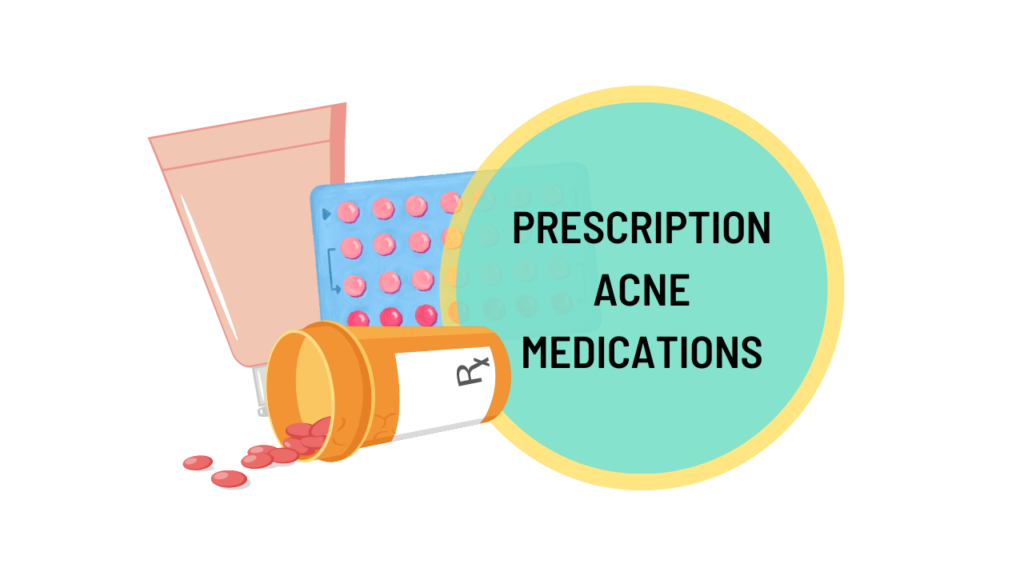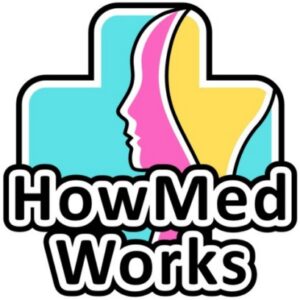
We’ve covered over-the-counter acne ingredients so let’s move on to the stronger ingredients that require a prescription. These are ingredients that work best if you have more severe acne
so let’s move on to the stronger ingredients that require a prescription. These are ingredients that work best if you have more severe acne or adult acne
or adult acne .
.
Moderate to severe cases of acne typically don’t go away on their own and thus require more specialized treatment. Since stronger products come with the risk of more severe side effects, you’ll only be able to obtain them through a doctor. Let’s jump right into it and be sure to stick around until the end for a master chart on all the acne ingredients!
Table of Contents
Prescription Acne Treatments
Clindamycin
Clindamycin is a topical antibiotic used to treat moderate acne. Like benzoyl peroxide, clindamycin kills acne-causing bacteria, effectively targeting inflamed acne. Clindamycin isn’t preferred for treating milder forms of acne, such as blackheads and whiteheads, since they aren’t considered inflamed forms of acne.
The main downside of clindamycin is that it can cause some unpleasant side effects, including dryness, itchiness, redness, and a burning sensation. For this reason, it’s highly recommended you use a small amount, moisturize well, and apply ample amounts of sunscreen.
Important Takeaway: Consistency and patience are required for treating acne! Skincare products take time to work so it might be awhile before you begin to see results. Just remember to stick to your routine as instructed and use any acne medication for a minimum of six to eight weeks before considering a different product.
Oral Antibiotics
Tetracycline, doxycycline, and minocycline are oral antibiotics commonly used to treat moderate to severe acne. Tetracycline is the “parent” of doxycycline and minocycline, as it was the first of this class of acne-fighting compounds before its derivatives came around. They all have similar structures and target acne-causing bacteria, making them good options for the more severe, inflamed acne types: pustules, papules, nodules, and cysts.
What’s the Difference Between Doxycycline, Minocycline, and Tetracycline?
While one study showed that minocycline may produce slightly better results, another noted doxycycline to have fewer side effects. Thus, the true winner when it comes to these two is still up for debate. The same goes for tetracycline. It really comes down to perceived effectiveness and differences in potential side effects. It’s best to discuss the pros and cons of each with your doctor to decide which one might be best suited for you.
Warning: Tetracycline, doxycycline, and minocycline should be avoided during pregnancy, as they can inhibit proper bone and teeth formation in the unborn baby.
Oral acne medications are generally more potent than topical ones, since topical treatments are limited to acting on just the skin-level. While there are other oral medications for moderate and severe acne, many are not options for males–for reasons we’ll later discuss. Because of this, males that require more aggressive acne treatment will typically be prescribed tetracycline or one of its derivatives.
Spironolactone
Oral Spironolactone
Spironolactone is a medication that has been around for over 50 years. It’s used to treat a number of things, including hypertension, edema, and heart failure. One of spironolactone’s main uses is treating moderate to severe acne in females, particularly adult acne. As we discussed already in Part 2 , adult acne overwhelmingly affects women more than men due to the fact that it’s largely hormone-based, and women experience more hormone fluctuations throughout their lives (e.g. menstrual periods, pregnancy, menopause.) compared to men.
, adult acne overwhelmingly affects women more than men due to the fact that it’s largely hormone-based, and women experience more hormone fluctuations throughout their lives (e.g. menstrual periods, pregnancy, menopause.) compared to men.
Spironolactone is an excellent treatment for hormonal acne because it works by blocking androgens (male hormones). By blocking androgens, hormone levels stabilize, and less acne forms. Oral spironolactone is actually one of the treatments that cleared up my acne! 🙂
Prescribing oral spironolactone as an anti-acne agent for males is avoided. (Sorry, guys.) Males require higher levels of androgens in order for the body to function properly, and blocking androgens would cause unwanted side effects. There are other conditions where oral spironolactone is prescribed for males, but the dosage is often much lower than the level prescribed for acne-lowering effects.
Topical Spironolactone
While oral spironolactone isn’t an option for males, topical spironolactone is. This is because the effects of topical spironolactone are localized to the skin and haven’t been found to produce systemic side effects. The one downside to topical spironolactone is that it’s not widely available at this point in time. However, you can find it at Apostrophe.com, an online dermatology service. If you’re interested in learning more about Apostrophe, be sure to stick around until the end of this article, where I’ll talk about it in more detail.
Warning: Spironolactone must be stopped if pregnancy is suspected because its anti-androgenic properties can impair fetal development.
Birth Control
While the main purpose of birth control isn’t to treat acne, many find that it helps. This ties back to what we discussed regarding spironolactone; birth control is a way of regulating hormone levels, which can have acne-improving effects. The best birth control option for reducing acne is the combination pill, which includes both estrogen and progesterone. There are many different brands that carry a combination pill, including Yaz, Nikki, and Loestrin.
Birth control pills have been cited to treat a variety of acne. Personally, I didn’t notice any difference in my skin after starting on combination pills. Very often, birth control pills will be used in conjunction with other acne medications to get the best results.
Retinoids
Tretinoin (Topical Retinoid)
Tretinoin is a potent, topical retinoid, or vitamin A derivative. While it can be used to treat mild and moderate acne, tretinoin is extremely effective for severe acne, especially cystic and hormonal acne. It works by penetrating deep into the skin, speeding cell turnover, and unclogging pores. (This is the other ingredient that made a huge difference in my skin!)
Tretinoin usually comes in concentrations ranging from 0.025% to 0.1%. This ingredient can cause irritation, especially in those with sensitive skin so it’s recommended that you apply just a pea-sized amount and start off using the product a couple of nights per week. If tolerated, you can slowly increase to daily use. Don’t forget to use extra moisturizer and SPF! For more tips on how to use tretinoin, check out this article.
Isotretinoin (Oral Retinoid)
The last-resort treatment that dermatologists will prescribe if all else fails is isotretinoin. Isotretinoin targets acne systemically and from all different angles, making it extremely effective at clearing severe nodular and cystic acne.
Fun Fact: Isotretinoin was largely known to the mainstream by a different name: Accutane. The two are the same; Accutane was just a brand name version. Accutane was discontinued in 2009 due to reasons related to profit, not safety or efficacy. Even though Accutane is off the market, there are still generic formulations that are available today.
Here’s how isotretinoin works:
- Isotretinoin shrinks oil glands. When oil glands shrink, less oil is produced, which means there’s a much smaller chance of pores becoming clogged and forming acne.
- Pores become a less habitable environment for P. acnes bacteria because the decreased oil production gives P. acnes less to feed on, stunting its proliferation.
- Anti-inflammatory and keratin-normalizing properties of isotretinoin reduce the severity of breakouts, which effectively decreases the amount of permanent scarring.
The effects of isotretinoin are long-lasting and often permanent, since the compound causes structural changes and targets the root causes of acne. Although undergoing more than one course of isotretinoin is not unheard of, most patients only need one treatment course to achieve skin clarity for the rest of their lives.
Even though isotretinoin is the closest thing we have to a cure for acne, you should exhaust all other options before considering isotretinoin because it’s associated with some harsh side effects.
Common Side Effects of Isotretinoin:
- Extremely dry skin
- Cracked skin
- Itchiness
- Rash
- Dry mouth
- Dry lips
- Dry nose
- Nosebleeds
- Dry eyes
- Inflammation of the eyes
- Bone and/or joint pain
- Depression
Taking isotretinoin also requires regular monitoring of labs so make sure that this is something you’re certain about and are prepared for. Finally, isotretinoin is not an option for individuals who are pregnant or may become pregnant because it can cause severe birth defects.
Final Thoughts
For all of you visual learners, here’s a succinct chart outlining the key points of all the acne medications we discussed in this article:

As you can see, there are lots of options when it comes to prescription acne treatments. Hopefully now you have a better idea of the options out there so you’ll be able to have a more informed conversation with your dermatologist. The main thing to remember about prescription-only ingredients is that they often come with harsher side effects so make sure to compensate by keeping the rest of your skincare regimen simple and using lots of moisturizer and sunscreen. 🙂
Conclusion
If you’re experiencing bad breakouts, just remember that it’s completely normal and nothing to be ashamed of. I know from personal experience that acne can be very painful, both physically and psychologically. However, more and more people are opening up about their acne journey, and there’s an increasing emphasis on healthy skin over perfect skin. 🙂
I hope you enjoyed this article as much as I enjoyed writing it. If you’re looking to learn more about acne, be sure to check out some of my other articles:
- Acne Treatments 101: Over-the-Counter Ingredients

- A Guide to Skincare: The 6 Types of Acne

- A Guide to Skincare: Top 10 Causes of Acne

- The Differences Between Teenage And Adult Acne

Stay healthy and keep learning!
